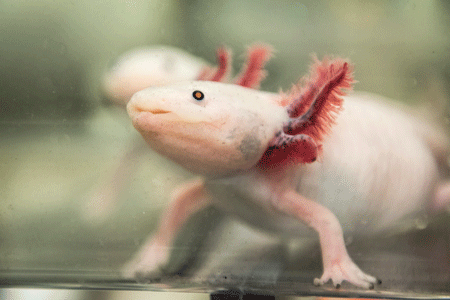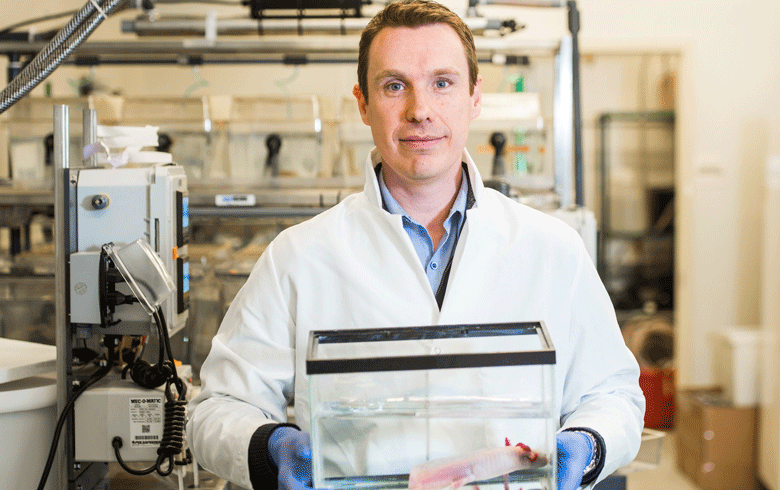Many salamanders can readily regenerate a lost limb, but adult mammals, including humans, cannot. Why this is the case is a scientific mystery that has fascinated observers of the natural world for thousands of years.
Now, a team of scientists led by James Godwin, Ph.D., of the MDI Biological Laboratory in Bar Harbor has come a step closer to unraveling that mystery with the discovery of differences in molecular signaling that promote regeneration in the axolotl, a highly regenerative salamander, while blocking it in the adult mouse, which is a mammal with limited regenerative ability.
“If we can solve the problem of scar formation, we may be able to unlock our latent regenerative potential.”
“Scientists at the laboratory have been relying on comparative biology to gain insights into human health since its founding in 1898,” said Hermann Haller, M.D., the institution’s president. “The discoveries enabled by James Godwin’s comparative studies in the axolotl and mouse are proof that the idea of learning from nature is as valid today as it was more than 120 years ago.”
Instead of regenerating lost or injured body parts, mammals typically form a scar at the site of an injury. Because the scar creates a physical barrier to regeneration, research in regenerative medicine at the laboratory has focused on understanding why the axolotl doesn’t form a scar—or, why it doesn’t respond to injury in the same way that the mouse and other mammals do.

“Our research shows that humans have untapped potential for regeneration,” Godwin said. “If we can solve the problem of scar formation, we may be able to unlock our latent regenerative potential. Axolotls don’t scar, which is what allows regeneration to take place. But once a scar has formed, it’s game over in terms of regeneration. If we could prevent scarring in humans, we could enhance quality of life for so many people.”
The axolotl, a Mexican salamander that is now all but extinct in the wild, is a favorite model in regenerative medicine research because of its one-of-a-kind status as nature’s champion of regeneration. While most salamanders have some regenerative capacity, the axolotl can regenerate almost any body part, including brain, heart, jaws, limbs, lungs, ovaries, spinal cord, skin, and tail.
Since mammalian embryos and juveniles have the ability to regenerate—for instance, human infants can regenerate heart tissue and children can regenerate fingertips—it’s likely that adult mammals retain the genetic code for regeneration, raising the prospect that pharmaceutical therapies could be developed to encourage humans to regenerate tissues and organs lost to disease or injury instead of forming a scar.
In his recent research, Godwin compared immune cells called macrophages in the axolotl to those in the mouse with the goal of identifying the quality in axolotl macrophages that promotes regeneration. The research builds on earlier studies in which Godwin found that macrophages are critical to regeneration: when they are depleted, the axolotl forms a scar instead of regenerating, just like mammals.
The recent research found that although macrophage signaling in the axolotl and that in the mouse were similar when the organisms were exposed to pathogens such as bacteria, funguses and viruses, when it came to exposure to injury it was a different story: the macrophage signaling in the axolotl promoted the growth of new tissue while that in the mouse promoted scarring.
The discovery of an alternative signaling pathway that is compatible with regeneration could ultimately lead to regenerative medicine therapies for humans. Though regrowing a human limb may not be realistic in the short term, significant opportunities exist for therapies that improve clinical outcomes in diseases in which scarring plays a major role in the pathology, including heart, kidney, liver, and lung disease.
“We are getting closer to understanding how axolotl macrophages are primed for regeneration, which will bring us closer to being able to pull the levers of regeneration in humans,” Godwin said. “For instance, I envision being able to use a topical hydrogel at the site of a wound that is laced with a modulator that changes the behavior of human macrophages to be more like those of the axolotl.”


